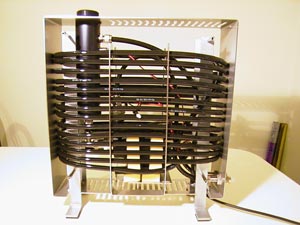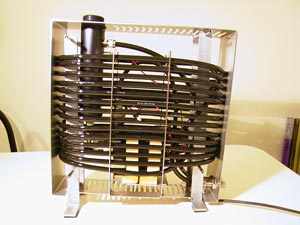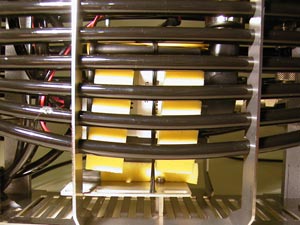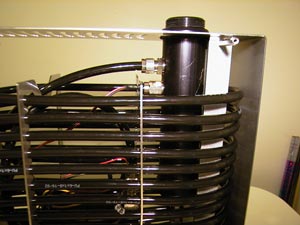|
|
Advertisement:
|
|
Xice ExternalCool Watercooling Kit |
|
Join the community - in the OCAU Forums!
|
Inside the ExternalCool

After undoing 4 screws the ExternalCool's side panels are easily removed, exposing the external workings. The major surprise is that there is no traditional, purpose-built radiator! The ExternalCool's passive cooling capacity is provided by the rather simple means of convection-induced airflow around about 9m of plastic pipe. But upon closer inspection the design and construction of the ExternalCool is really very impressive.
The theory behind the ExternalCool is explained by Xice on their website: "The heat exchange through our product ExternalCool is aided by the "rising chimney effect". The refrigerating capacity is more than sufficient for known AMD/Athlon and Intel/P4-processors. Further components, e.g.graphic card, can be integrated into the cooling circuit without problems."
Personally, I was sceptical as to how well a passive cooling system, without a traditional high-density radiator would actually work; the design simply relies on the surface area of the plastic pipe tubing to dissipate heat. I expected that the passive design would require a greater cooling surface area - or at least, metal tubing instead of plastic hoses to provide better thermal dissipation. However, as we'll see later, the Xice kit performs quite well. When you take into account that it's virtually silent, its performance is impressive indeed.

When I had removed the two side panels and left the ExternalCool on the bench for a while, I thought I had somehow broken it when it started to sag as shown in the picture above. However, a closer inspection indicated that the 'floating' design of each of the ExternalCool's internal components was simply another design step to help ensures very quiet functionality. The interior design of the ExternalCool works something like this: The black side panels screw into the upright legs via four screw points, and when screwed in place the side panels support the internal silver frame. The frame is not actually attached to the legs and is able to 'float' up and down - this is what you can see in the photograph above. Attached to the base of the silver frame are two upright brackets, these support a pump mounting platform and slots to secure each consecutive loop of tubing.

Keeping with the maximised noise and vibration reduction design, the pump is not actually screwed or bolted to any part of the ExternalCool frame. Instead, it is insulated with a number of pieces of foam and secured via a loop of rubber-elastic to the pump mounting platform. The result is that the only mechanical - and therefore noise or vibration producing - component in the entire setup is insulated and isolated several times over.

The pump, comfortably secured in the middle of the ExternalCool, is a 12V 10W model made by OASE. Apparently OASE are a German company who have been making aquarium and fountain pumps and related components for some years. The pump has a capacity of 900 l/hour, and has 1/4" threaded connectors, but of course our ExternalCool was supplied with the pump pre-connected.

The ExternalCool reservoir. The top metal connection is the water inlet, and just below it is the LED mount. The water outlet is at the base of the reservoir and can't be seen in this photo.
Heated cooling fluid arrives at the ExternalCool's intake and is piped - via one continuous piece of tubing - around the inside of the ExternalCool. The loops of tubing are positioned so that the hot water circulates at the top of the unit and the cooler liquid around the lower loops of the unit. After travelling around the 14 passive cooling loops of the ExternalCool the water is then discharged into the reservoir. The base of the coolant tank is fitted with an outlet and t-junction to allow the fluid to be sucked directly into the pump and out the outlet on the outside of the ExternalCool unit.
When the Xice unit is in operation, passive convection draws cooler air in via the slots at the bottom of the unit and warmer air is exhausted out the top. While working, a noticeable difference - about 10degC - in air temperature between the bottom and the top of the unit, indicates that the ExternalCool's passive cooling technique works well.
Just out of interest I decided to run the ExternalCool in its 'bare' state, without the side panels in place, to see if there would be any difference in performance. In the hottest and maximum overclocked scenario (see results page), removing the sides on the ExternalCool allowed the CPU to be cooled by an additional 2 to 3 degrees C. Again, and simply for the sake of curiosity, I attached a quiet 120mm Antec fan - via cable ties - to the 'bare' ExternalCool, and by forcibly drawing air across the exposed radiation loops was able to achieve an additional 2 to 3 degree CPU cooling performance increase. However, one of the major advantages of the ExternalCool is its impressive design looks and its silent cooling capabilities, so it's unlikely anyone would purchase the system and then run it in either of these two configurations.
|
|
Advertisement:
All original content copyright James Rolfe.
All rights reserved. No reproduction allowed without written permission.
Interested in advertising on OCAU? Contact us for info.
|

|


